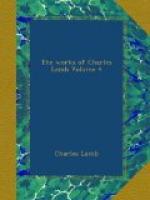It is easy to laugh at such incongruities as are met together in this picture,—incongruous objects being of the very essence of laughter,—but surely the laugh is far different in its kind from that thoughtless species to which we are moved by mere farce and grotesque. We laugh when Ferdinand Count Fathom, at the first sight of the white cliffs of Britain, feels his heart yearn with filial fondness towards the land of his progenitors, which he is coming to fleece and plunder,—we smile at the exquisite irony of the passage,—but if we are not led on by such passages to some more salutary feeling than laughter, we are very negligent perusers of them in book or picture.
It is the fashion with those who cry up the great Historical School in this country, at the head of which Sir Joshua Reynolds is placed, to exclude Hogarth from that school, as an artist of an inferior and vulgar class. Those persons seem to me to confound the painting of subjects in common or vulgar life with the being a vulgar artist. The quantity of thought which Hogarth crowds into every picture would alone unvulgarize every subject which he might choose. Let us take the lowest of his subjects, the print called Gin Lane. Here is plenty of poverty, and low stuff to disgust upon a superficial view; and accordingly a cold spectator feels himself immediately disgusted and repelled. I have seen many turn away from it, not being able to bear it. The same persons would perhaps have looked with great complacency upon Poussin’s celebrated picture of the Plague at Athens[1] Disease and Death and bewildering Terror, in Athenian garments, are endurable, and come, as the delicate critics express it, within the “limits of pleasurable sensation.” But the scenes of their own St. Giles’s, delineated by their own countryman, are too shocking to think of. Yet if we could abstract our minds from the fascinating colors of the picture, and forget the coarse execution (in some respects) of the print, intended as it was to be a cheap plate, accessible to the poorer sort of people, for whose instruction it was done, I think we could have no hesitation in conferring the palm of superior genius upon Hogarth, comparing this work of his with Poussin’s picture. There is more of imagination in it—that power which draws all things to one,—which makes things animate and inanimate, beings with their attributes, subjects, and their accessories, take one color and serve to one effect. Everything in the print, to use a vulgar expression, tells. Every part is full of “strange images of death.” It is perfectly amazing and astounding to look at. Not only the two prominent figures, the woman and the half-dead man, which are as terrible as anything which Michael Angelo ever drew, but everything else in the print, contributes to bewilder and stupefy,—the very houses, as I heard a friend of mine express it, tumbling all about in various directions, seem drunk—seem




